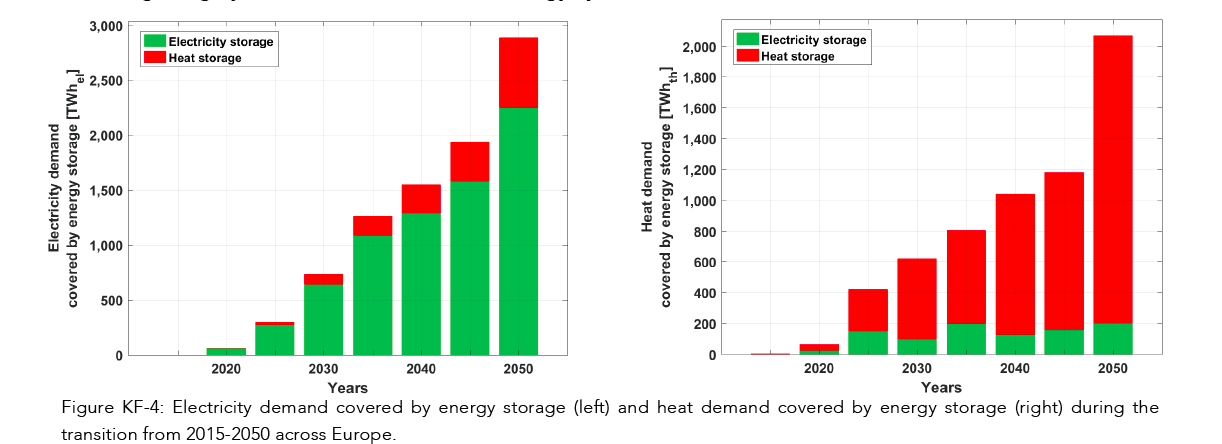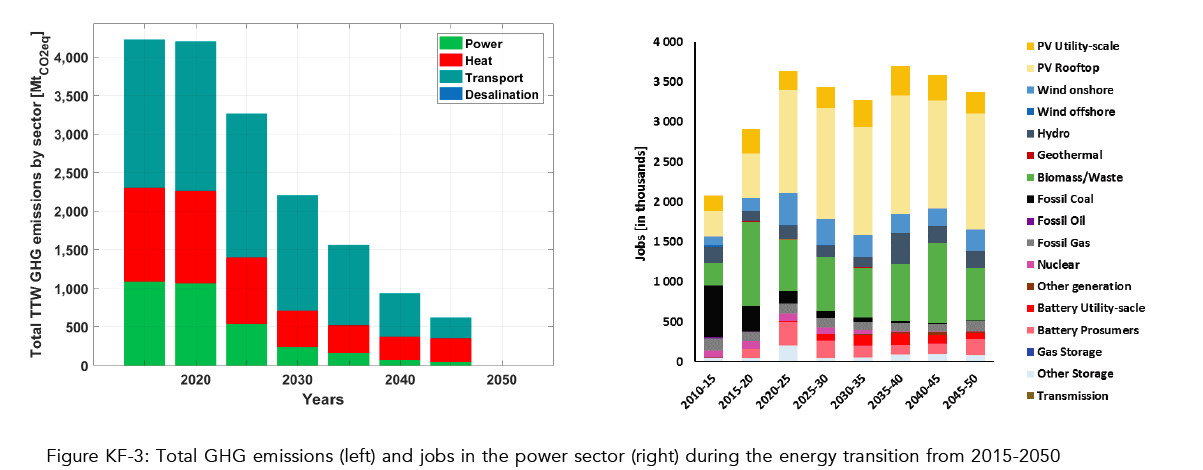A new study published by the Energy Watch Group and LUT University, and funded by Deutsche Bundesstiftung Umwelt, states that it is not only possible for Europe to transition to a world powered 100% by renewables by 2050, but that it would create more jobs and be more cost effective than the present fossil fuel-led system.
At a RENAlliance panel on the sidelines of this year's COP, the researchers presented what they say is a “technically feasible and economically viable energy pathway for Europe, in which the energy sector (comprising power, heat, transport, and desalination) can reach 100% renewable energy and zero greenhouse gas emissions by 2050.”
The transition can be made on existing renewable energy potential and technologies, say the researchers, who state, “The energy transition is not a question of technical feasibility or economic viability, but one of political will.”
The details
Based on their calculations, the researchers say primary energy demand would decrease from 21,000 TWh in 2015 to around 20,000 TWh by 2050, driven by “massive” energy efficiency gains and an over 85% electrification rate. Fuel consumption, meanwhile, would be reduced by more than 90% from 2015 numbers, as fossil fuels are completely phased out.
Leading the charge in this 100% renewable energy system is solar PV, which is projected to generate 62% of electricity by 2050 and become the lowest cost energy source. It will be followed by wind energy at 32%, hydropower at 4%, bioenergy at 2% and geothermal energy at <1%.
“Wind and solar make up 94% of total electricity supply by 2050 and will have a synergetic balancing effect,” continues the study.
 In terms of energy storage, the researchers believe that in their scenario, the sector will meet nearly 17% of electricity demand and around 20% of heat demand. Overall, installed electricity storage capacity will increase from just 0.3 TWh in 2015 to around 7.4 TWh by 2050, they calculate.
In terms of energy storage, the researchers believe that in their scenario, the sector will meet nearly 17% of electricity demand and around 20% of heat demand. Overall, installed electricity storage capacity will increase from just 0.3 TWh in 2015 to around 7.4 TWh by 2050, they calculate.
Batteries will emerge as the most relevant electricity storage technology, they say, while thermal energy storage will become the most relevant heat storage technology by 2050. “Electric heat pumps will also play a significant role, generating more than 30% of heat on district and individual levels by 2050.”
Costs
While many may not want to believe it, the researchers say that this new world will be more cost-effective than the present energy system.
Looking at the levelized cost of energy, they say that it will remain stable between 2015 and 2050, ranging from €50-60/MWh. For electricity, levelized costs are predicted to “substantially” decrease, from around €80 /MWh in 2015 to around €57/MWh by 2050; while the levelized costs of heat are set to increase “marginally” from around €41/MWh in 2015 to around €43/MWh by 2050.
Zero emissions
The result of transitioning to 100% renewables will be a steady decline in annual greenhouse gas emissions from about 4,200 MtCO2eq in 2015 to zero by 2050, reads the study.
Popular content
“The resulting cumulative greenhouse gas emissions are approximately 85 GtCO2eq from 2016-2050, and would support the EU’s goal of limiting temperature increases to 1.5°C above pre-industrial level,” it continues, adding, “In contrast to popular claims, a deep decarbonisation of the power and heat sectors is possible by 2030 in Europe. The transport sector will lag behind, with a massive decline of greenhouse gas emissions from 2030 to 2050.”
Job creation
According to the study, in 2015, roughly 2 million people were employed in the European power sector. It calculates that if its plan were to be implemented, jobs for 3 million to 3.5 million people would open up, predominantly in the solar PV industry, with around 1.7 million placements expected in 2050.
Asked by pv magazine at the live launch how RENAlliance can promise that new renewable energy jobs will go to formerly coal-dependent areas, Hans Josef Fell, Energy Watch Group President told Max Hall that the group can only give an overview and that it was down to politicians to ensure that it happens. “That is an entirely understandable response but surely not one that would reassure skeptical voters in areas like this, Poland’s coal belt of Upper Silesia,” wrote Hall.
Achieving utopia
Rather than make the claims and then walk away, the researchers have been ever so kind to the politicians and policy makers gathered at COP, laying out eight measures they could adopt to achieve this utopia.
“… governments need to adopt national legislative acts that will ensure the swift uptake and development of renewable energy and storage technologies, sector coupling and smart energy systems,” they state.
They are:
- Policies and instruments focusing on sector coupling
- Instruments enabling direct private investments in renewable energy and other zero-emission technologies – Here the study says that FITs are preferable to tenders, which are “limiting deployment” of renewables and should be kept for projects of 40 MW or over; and that decentralized actors should be focused on
- Tax exemptions, direct subsidies and legal privileges for renewable energy technologies
- The phasing out of all fossil and nuclear subsidies
- Energy consumption must be efficient and demand must be supplied solely by renewable energy – High efficiency buildings, lighting, electric appliances, electronic devices, and other energy loads need to be supported by responsible policies, regulation, mandates, and infrastructure planning, says the study. Efficient transport systems that are powered by renewables will reduce energy demand it adds
- Promoting co-generation power and heat
- Introducing carbon and radioactivity tax
- Promoting research and education in the sphere of renewable energy and zero emission technologies
The 41 page study, Energy Transition in Europe Across Power, Heat, Transport and Desalination Sectors, is part of a larger global study on the same.
The live presentation
Read about the presentation earlier today on pv magazine's blog, which is being updated live in Katowice by editor Max Hall. There, he noted that while it plays a key role in the report, no representative from PV was on the RENAlliance panel. Meanwhile, he said that the gathering also illustrated the difficulties of finding a united voice among competing renewable technologies.
“There is a certain inevitability about the comments of the panel’s representatives from the geothermal and bioenergy sectors, perhaps not surprisingly given the mealy mouthed less-than-3% the alliance says they will supply to the EU energy mix in 32 years’ time,” wrote Hall.
He went on to quote Beata Kepinska, of the Polish Geothermal Society, who said the “potential for geothermal is much higher than reflected in the study”. Meanwhile, Remigijus Lapinskas, of the World Bioenergy Association, said the report he is here to publicize should “contain more space for different scenarios”, no prizes for guessing which ones.
Lapinskas pressed the case for sustainably sourced bioenergy, with the argument, “I hardly believe we can drastically change the energy system of the world to be based only on electricity. “Transportation, in most cases I hardly believe electricity will run the ships on our oceans… our aircraft, or long distance trucking,” he added.
This content is protected by copyright and may not be reused. If you want to cooperate with us and would like to reuse some of our content, please contact: editors@pv-magazine.com.






Please. There isn’t a rational scenario that has renewables at less than 90% by that time anyway. With zero action.
The plan shouldn’t be about percentages, it should be about creating truely open energy markets so the far superior and less expensive technology can dominate.
Mandate the necessary amount of storage as a public utility and let the market do the rest.